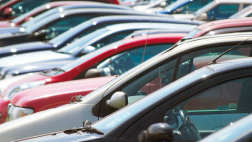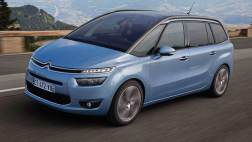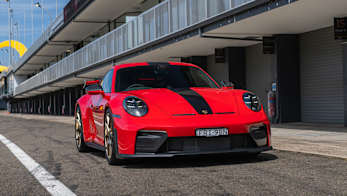You'd think about buying this one. With your own money, that is.
That's the remarkable thing about Toyota's Camry (and that adjective sharing the same sentence as this car is, in itself, rather remarkable). Despite being as commonplace as sand in the Simpson, despite the plethora of four time owners for whom Camry is synonymous with “car”, some 60 per cent are white entry level jiggers flogged to fleets.
These then proceed into the used market and faithfully serve their undemanding owners for up to a decade or far more. You see them daily, an endorsement of Toyota reliability but not a boon to Toyota profitability.

The real money is yours and mine; that of the private new car buyer.
But when it comes to the middle-size class segment, we're apt to head to the showrooms of Mazda, Honda, Subaru or if we've about $40K to spend to those of the German duo, Ford Mondeo and Volkswagen Passat. If this crowd was not enough, Camry's traditional constituents are being targeted by Hyundai's i45.
These mid-size sedans are all visually appealing and (excepting the i45) dynamically adept, discernibly beneath the Euro prestige set, but commanding a bit of badge respect. This no one can plausibly claim for the Camry.
If common associations include: “safe”, “solid” and “reliable”, another is: “bowling lady's car”.
The difficulty for Toyota in grabbing a slice of the private pie is enticing first time buyers without alienating core punters.
So how do you make vanilla interesting? It seems an insurmountable ask.
Carsguide was among a select group of Australian journalists the first invited to Toyota's vast North American Proving Grounds outside Phoenix, Arizona to sample pre-production examples of the new generation Camry two months before this today’s worldwide unveiling.
VALUE
To the plethora of existing specification levels - some of which won’t survive - comes the new Atara, one crammed with standard fruit, very much the anti-fleet Camry. Its comparative opulence is reflected by the name.
Camry as few of us know means “crown”. Atara is Hebrew for “new crown”. So a Toyota Double Crown needs to be fit for household's king and queen at a plebeian price.
The latter we won't know until this week, but it's reasonable to guesstimate that while the range will continue to kick off from about $30K, the Atara will be in the region of 40, certainly in Hybrid form.
For that, the user chooser will get kit that until recently was the preserve of prestige machines, including a blind spot monitor with wing mirror warning light, touchscreen audio, auto high-beam, shifting paddles and wing mirror integrated indicators.
Moreover the Ataras we sampled were of a palpably improved, almost Lexus level of quality.
DESIGN
Head engineer Yukihiro Okane says the key words in developing the new sedan were “rational” and “emotional”.
While hardly inspiration for lyric poetry, this Camry is more distinctive at any rate not invisible with a more purposeful front and angular rear. Aerodynamic measures, Oaken-san says, are derived from Formula 1, which makes this family car maker's involvement in elite racing seem slightly less bewildering.
No panels are shared with the current device, but it's mainly a case of upgrading the Camry's off the rack suit to something sharper. Some of the tailoring works.
Even on 17-inch alloys, the bulky body looks under tyred (though, practically speaking, it isn't). That pays off with ease of egress through huge rear doors.
The only practical objections to the current Hybrid are an inability to tow and its truncated boot. Technically, the former can't be helped, but with 430-litres stowage the latter question mark over its family suitability is addressed.
It's within that the changes are most marked. Occupant space is fractionally improved and the enhanced materials have a look and tactile feel that wouldn't appear out of place in Toyota's luxury Lexus line-up. When you hear yourself making approving noises about the door insert materials, you know you've landed in a comfortable place.
TECHNOLOGY
Performance is up, juice use is down, due to a new 2.5-litre four cylinder that in conventional form puts out a class competitive 135kW/235Nm. “New”, that is, to Australia it's been in US-built Camrys for some time, hence Okane-san looks a bit abashed when we wonder why Toyota hasn't moved to a more efficient direct injection model a la VW, Hyundai and, soon, Mazda.
Even so it will, he says, use less than 8L/100km of basic unleaded. Logically the Hybrid could challenge Holden's Cruze diesel manual for the title of the leanest locally made car the current Hybrid uses 6.0-litres over the 100, the cheaper and smaller Cruze consumes 5.6.
SAFETY
Seven airbags as standard is one better than the class average. These, and new items such as automatically dimming high beams, will ensure the current model's five star crash safety rating is readily retained.
DRIVING
Toyota's desert proving ground is a mighty facility, in which all conceivable road conditions are encountered. We take the opportunity to repeatedly push these pre-production Ataras on a high speed freeway run, then over broken (all too Australian) bitumen, through a skidpan dotted with witches' hats and along a coarse chip suburban-like strip.
Never synonymous with performance, the new Camry's improved output is immediately apparent, getting it off the mark smartly and pulling quickly and cleanly through its six gears, cruising easily up to its electronically limited 180km/h. Backing way off for the slalom, it's almost bemusing to find a Camry responding this smartly to steering inputs (which will be further refined for Australian production), the stability program triggering only under determined provocation.
Absent is the acquatic lurching half expected in an American made car. This bodes promisingly for locally developed and manufactured model.
While we're by no means talking of sport sedan dynamics, this Camry clearly has a capability that will be more than enough for most people most of the time.
It's the petrol electric version that most impresses though, with its almost instantaneous, completely linear power delivery and eerie quietness at speed, when the only noise is the whistle of wind past the wing mirriors. Now possessed of practical storage, this could be the pick of the Atara range and the hybrid sedan that breaks through to the mainstream.
VERDICT
The Camry remains vanilla, but of a richer, creamier blend essentially the same but slightly more appetising. There's a bit more power, slightly better economy and appreciably more gear. Being a Toyota, ownership is devoid of excitement, but it's also going to be free of difficulty. Get past the badge and it's hard to see how the Hybrid is bettered a lean-running, two kid family conveyance.
“The Camry remains vanilla, but of a richer, creamier blend essentially the same but slightly more appetising.”
CAMRY HISTORY
WHAT DOES IT MEAN?
Camry - from the Japanese Kan-Muri, meaning "crown".
WHERE IS IT BUILT?
Camry and its four-cylinder engine are built at Toyota's Altona manufacturing plant in Melbourne, Victoria. Toyota directly employs 3,200 people in Victoria and more than 4,400 nationally.
HOW MANY?
Approximately 100,000 four-cylinder Camry sedans are produced at Altona each year. Approximately 70 per cent are exported, mainly to the Middle East. Camry has been produced in Australia since 1987.
HOW SUCCESSFUL?
Camry is now in its 18th year as Australia's best-selling mid-size car. It is also Australia's biggest automotive export earner, being shipped to more than 20 destinations.
BACKGROUND
Launched in the wake of the oil shocks of the late ’70s, Camry has established itself as a true world car. Planning for the Camry began in 1977, at a time when manufacturers globally were turning to smaller front-wheel-drive vehicles to overcome soaring fuel costs and stricter fuel efficiency regulations. The emphasis of the program was on aerodynamics and lightweight materials.
Engine development focused on fuel efficiency, with engines built specially to drive the front wheels. Around the world, Camry production has now passed 15 million units.
1983 – first generation (imported)
The Camry was introduced to Australia as an import in liftback guise in 1983. It won several "best car" awards, including Modern Motor magazine’s Car of the Year. The car featured a new five-speed manual and ECT-equipped four-speed automatic transmissions with wide gear ratios. The front-wheel-drive layout, without a transmission tunnel, allowed for a spacious interior.
Innovations in the first Camry included equal-length driveshaft arms, two-stage air conditioning and multi-adjustable seats. That tradition of innovation continued throughout the life of the Camry and the brand is now synonymous with world-leading sophistication and quality.
1987 – second generation, but first locally produced Camry
It wasn’t until the second-generation Camry that the car was built locally. AMI-Toyota was the first Toyota subsidiary in the world to build the Camry and the local version incorporated extensive design changes – including three locally designed wagon variants. The Australian-made Camry made its showroom debut in April 1987, replacing the locally built Corona.
With this generation, Toyota introduced a locally built twin-cam 2.0-litre 16-valve four-cylinder engine, followed in May 1988 by a new 2.5-litre quad-cam 24-valve V6. The engine was the world’s first quad-cam V6 engine to feature in a mass production sedan. This generation also saw the release of a station wagon to replace the hatchback.
Camry allowed Toyota to compete on equal footing with the other leading medium cars of the day – Mitsubishi’s Magna, Holden’s Camira and Nissan’s Pintara.
The Australian-built car featured independent front and rear Macpherson-strut suspension, engine-speed-sensitive power steering and disc brakes front and rear. It brought a new level of sophistication and technology to the local market.
A revised Camry appeared in August 1989, incorporating local steering modifications that were to gain international acceptance within Toyota. An Australian team revised the steering valve and geometry to improve driver feel and response. The changes were later adopted for worldwide Camry production.
Toyota continued to push for quality improvements. It was determined that investment in a new plant was necessary to achieve further gains. The proposal to build a new Camry plant at Altona was presented to Toyota Motor Corporation, which approved the plan to build a $420 million assembly plant at Altona.
1993 – third generation
In February 1993, the new wide-bodied Camry was launched publicly by Prime Minister Paul Keating, who described the car as “another quantum leap in the history of the Australian automotive industry”.
Wheels magazine agreed and Camry came out on top in a comparison with Magna, Mazda 626 and Liberty. Camry was also the top-ranked local car in Wheels’ annual quality survey and won the NRMA’s gong for best medium car.
Camry grew up for this generation. It was larger in every dimension than the previous model, and became classified as "mid-size". The car was wider and longer than Cressida, with better performance, improved fuel economy, ABS and reduced NVH. It also had more local input into design and development. Built at a cost of $140 million, the range also featured a new brand name – the Vienta – for its V6 models.
Engines were now 2.2-litre four-cylinder units (producing almost as much power as the previous V6, but with four-cylinder economy), and 3.0-litre V6s.
That same year, Toyota began exporting the Camry to Thailand. By 1994, Altona exports were worth $160 million and the company announced that, by the year 2000, it aimed to export 30 per cent of its Altona Camry production. The year also saw Camry take over the mantle of Australia’s best-selling medium car.
The last Camry to be built at Port Melbourne rolled off the production line in December 1994. Two weeks later, the Camry was being built at Altona. There was little difference between the Port Melbourne and Altona vehicles, except for a new water-borne, environmentally friendly paint process at Altona.
In 1996, Victorian Premier Jeff Kennett was on hand to send off the first shipment of Camrys to the Middle East.
1997 – fourth generation
A new range was launched in August 1997. It was quieter, lighter and more powerful with better ride quality and improved handling. With an additional 5cm in wheelbase, a lowered beltline and swept-back windscreen, the 1997 Camry’s cabin was more spacious and inviting. By this time, 40 per cent of Camry production was being shipped overseas to 24 destinations.
The line-up of four-cylinder Camry models consisted of the CSI, Conquest and CSX models, available as sedans or wagons. Camry V6 models consisted of CSI and Conquest. Both of Camry’s engines received power and torque increases.
In October 2000, a revised Camry range was launched with improved handling, higher feature levels, improved headlamps and reduced noise, vibration and harshness. Two models were added to the Camry line-up - Touring Series wagon and top-of-the-range sports-luxury Azura sedan. The Vienta V6 range was discontinued due to the launch of the Avalon sedan.
Toyota Camry 2011: Atara S
| Engine Type | Inline 4, 2.5L |
|---|---|
| Fuel Type | Unleaded Petrol |
| Fuel Efficiency | 7.8L/100km (combined) |
| Seating | 5 |
| Price From | $9,680 - $13,310 |
| Safety Rating |
|
Pricing Guides













.jpg)
.jpg)